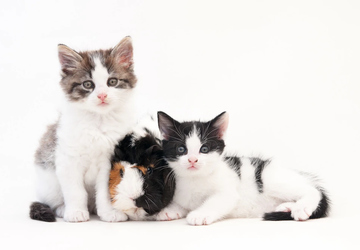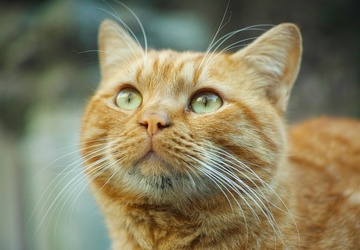Are you satisfied with your cat's well-being? Will your cat return your love? What does your cat like? What environment does your cat like? The answers to these questions lie in understanding cat behavior. To learn more about your cat, you need to understand the cat's communication medium.
It's important to understand cats' unique way of communicating. To create a strong bond with your feline friend, this article highlights the top ten signals cats use to communicate with their owners. This allows you to identify and decipher your cat's signals.
Tail Language
Cats often use their tails to express themselves. Knowing tail language will help you better understand your cat's needs and requirements. The various postures of the tail include standing upright, wagging, curling, twitching, blowing and curling the tail.
• A curved tail represents openness and accessibility, while an upright tail symbolizes security and calm.
• Twitches indicate intense concentration or excitement, while tail curls indicate fear or worry.
• Wagging back and forth indicates relaxation or anticipation, while a swollen tail indicates anger or fear.
By knowing this important idiom, you can create a comfortable atmosphere that enhances connection and communication.
Kneading and paddling
Kneading and paddling are common behaviors for cats to express affection. When kneading, the cat's front paws are pressed against the soft surface. It's associated with feelings of security, relaxation, and contentment, and is often seen as a sign of a cat's security. When paddling, the front and rear paws move rhythmically, often accompanied by grunts. Both behaviors are positive signs of affection and attachment.
Ear position and movement

Cats express their emotions through the position and movement of their ears. Observing and understanding a cat's ear position and movement can provide valuable insight into its mood and intentions. As a cat communicates, key ear signals include ears forward and slightly tilted, ears twitching constantly, ears flattened, one ear forward and one ear back. Cats squash their ears to indicate discomfort. Relaxed ears also indicate a sense of security and curiosity. Incorporating other body language cues with the ear and responding accordingly to movement can deepen your bond and foster a harmonious relationship.
Vocalize
Vocalization is an important communication tool that allows your cat to express her feelings, needs and wishes. Common vocalizations include meows, trills, grunts, growls, hisses, chirps, and howls.
• Meowing is a versatile vocalization that can mean different things.
• A cat's purr signals contentment and relaxation.
• A cat's defenses include growling and hissing, which indicate aggression or fear.
• A howl or howl is a loud, constant sound that expresses pain, discomfort or frustration.
• Silence can also be a form of communication, indicating illness or stress.
Each cat has a unique sound repertoire. Therefore, it is important to pay attention to their patterns and context when interpreting their vocalizations.
Posture
Cats communicate through their posture, which can reveal their emotions and intentions. Key postural cues that explain cat behavior include slouching, relaxing, arching, crouching or lying down, tipping over, body tension, and stiffness. These signals will help you understand your cat's emotional state and respond appropriately. By observing your cat's posture, you can create a safe and comfortable environment. Tailor your interactions to your cat's needs and create a stronger bond with your cat.
Grunt
Purring is a typical feline behavior that is often associated with contentment and relaxation. It conveys various emotions, such as seeking attention (a cute characteristic of cats) and serves several purposes. According to observation and research, cats purr when they feel content and relaxed. However, not every purr signifies happiness or contentment. If your cat's purring is accompanied by signs of discomfort, it is advisable to consult a veterinarian. Understanding context and body language cues can provide a clearer picture of their emotional state. Respond positively to her purrs like B. Show him affection or meet his needs to strengthen your bond.
Eye expression

Eye expressions are also critical to understanding a cat's behavior and feelings. Key gazes include relaxed and half-closed eyes, dilated or constricted pupils, staring or direct eye contact, and slow blinking.
• Pupil constriction indicates defensive or aggressive status.
• Relaxed eyes indicate contentment and relaxation.
• Dilated pupils indicate excitement, curiosity or arousal.
• Gazing or direct eye contact shows trust and affection.
• The slow wink, also known as the "cat kiss," is a friendly gesture that strengthens a bond.
Bite and scratch
Biting and scratching are natural behaviors for cats, but it's important to understand and address their causes. Playful biting and scratching is standard behavior, while overstimulation and fear or aggression may be defensive responses. To address these behaviors, use positive reinforcement techniques and avoid rough play. If your cat bites or scratches while playing, stop the interaction immediately. If biting or scratching persists or escalates, it is helpful to consult an animal behaviorist.
Hiss and growl
Cats hiss and growl when they feel threatened, scared or excited. A hiss is a sharp, high-pitched sound, while a growl is a low-pitched rumbling sound made when threatened or challenged. These defensive behaviors can serve as warnings of potential threats or to set boundaries. To address this situation, give your cat space, assess the situation, and create a calm environment. Remember that these behaviors are defensive and should not be punished as punishment will increase their anxiety. Patience, understanding, and a safe environment are key to making your cat feel safe and reducing its defensive responses over time.
Nursing behavior
Cat grooming behaviors include self-grooming, socialization, stress reduction, attention-seeking behavior, and behavioral problems. Cats are careful groomers, cleaning their fur with their tongues and teeth. Excessive grooming can lead to hair loss, skin irritation, or bald patches. However, be sure to consult a veterinarian if you notice excessive grooming. To encourage grooming behavior, keep the environment clean and brush regularly.
Conclusion
In conclusion, understanding cat behavior is important to building a strong and harmonious bond with your feline companion. By identifying and interpreting their signals, you can gain insight into their needs, moods, and well-being. Investing time and effort into understanding your cat's behavior will help you bond, improve communication, and keep your cat happier and healthier.